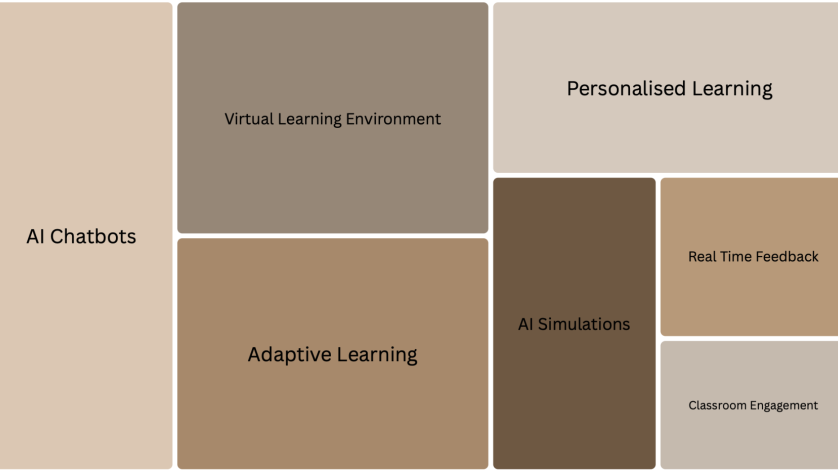
Inside a student-led SDG project transforming curricula
A structured approach for reviewing, mapping, and embedding the UN Sustainable Development Goals across the business school
- Home
- / Insights
- / Knowledge sharing
- / Is it time to embrace AI or abandon it in Higher Education?
Is it time to embrace AI or abandon it in Higher Education?

Authors

Dr Wenya Cheng
Senior Programme Lead and Senior Lecturer, Adam Smith Business School at the University of Glasgow

Dr. Sisir Ramanan
Lecturer, Adam Smith Business School at the University of Glasgow

Dr Yannis D. Tsafos
Lecturer, Adam Smith Business School at the University of Glasgow
Dr. Wenya Cheng, Dr. Sisir Ramanan and Dr. Yannis D. Tsafos from the Adam Smith Business School, University of Glasgow ask if is it time to embrace AI or abandon artificial intelligence in Higher Education.
In the age of artificial intelligence (AI), human intelligence is facing a profound challenge, prompting the need to rethink and perhaps even redefine what it means to be human as we stand at the crossroads of embracing or resisting the wave of transhumanism. While human history stretches back some 300,000 years to its origins in Africa, it wasn’t until the 18th century that the accumulation of knowledge and technology reached a critical juncture, sparking the Industrial Revolution and shaping the modern world as we know it.
This progression highlights that technological evolution does not follow a linear path but advances in unpredictable bursts. Economically, technological innovation has consistently driven capital and labour productivity, spurring economic growth and social prosperity. Unequivocally, we are on the verge of the fourth industrial revolution and - make no mistake - it is not propelled by steam, electricity, or machinery; this time, it is digital and empowered by connectivity, AI and human-machine interaction.
Is it time to embrace AI or abandon it?
Whether by fortune or design, we have been forced to navigate a world where human intelligence, in all its forms (mathematical, linguistic, emotional, spatial, musical, etc.), must coexist with artificial intelligence. Generative Pretrained Transformers (GPTs) - as conceived and created by humans - should, at the very least, take credit for making AI appear more human. GPTs feature efficient self-attention mechanisms, enabling them to respond quickly to various - increasingly complicated - queries by running large language models (LLM). ChatGPT - 4o at the time of writing this article - requires basic guidance and a couple of iterations to provide a logically sound and - more often than not - scientifically correct answer to a host of questions one could think of.
AI in Higher Education
The uptake of AI in higher education (HE) is growing at a remarkably fast pace and is mainly utilised for (a) assessment/evaluation, (b) predicting, (c) intelligent tutoring, and (d) managing student learning (Crompton & Burke, 2023). Naturally, this growing appetite for embedding AI in active learning practice has sparked a debate in higher education about the readiness of institutions to embrace such technologies, the ethical implications of AI, its impact on learning and, broadly, the need to introduce a regulatory framework that can effectively respond to the transformative power of AI (see Bond et al., 2024 for a systematic review).
75% of employers indicate that AI and ML become more important in the next decade
54% of employers feel business school graduates are prepared for AI skills
38% year-over-year growth in business school candidate demand for AI is observed
AI in learning and teaching practice of business schools
Recent developments in learning and teaching practice suggest that the adoption of AI technologies can personalise students' learning experiences and enhance learning outcomes through robust adaptive learning and iterative feedback processes alongside the following three pillars.
Personalise design of study material
Facilitate collaborative learning
Provide personalised feedback
All three pillars attempt to depart from the “one size fits all’’ learning experience that business education has followed for decades, failing to respond to individual student needs. We suggest that a more student-centred approach could benefit from innovations in machine learning and artificial intelligence. Such an approach could trigger and make the best use of inferential cues, allowing performance monitoring and self/collaborative improvement, especially in fields heavily reliant on text-based material (Noushad et al., 2024), as is often the case in business school subjects. Nevertheless, to accurately evaluate the efficacy of AI in enhancing student learning outcomes and developing graduate attributes, interdisciplinary research teams comprising experts from education, data science, and subject-specific disciplines should be mobilized.
A recent multinational study highlighted that the perceived ease of use and usefulness of AI tools like ChatGPT profoundly impact their adoption in business school classrooms. Students from diverse academic fields have shown positive attitudes toward AI, particularly in improving the efficiency of educational tasks and facilitating personalized learning (Abdaljaleel et al., 2024). These findings suggest that, when implemented thoughtfully, AI tools can help bridge the gap between individualized learning needs and traditional teaching methods, paving the way for more equitable and effective education.
How are educators using AI in business schools?

Source: Graduate Management Admission Council’s (GMAC) 2023 & 2024 Prospective Student Survey.
Educators are increasingly exploring and implementing AI tools in their classrooms, experimenting with various applications to enhance the learning experience. AI is transforming business schools by enhancing personalized learning, providing real-time feedback, and enabling adaptive learning paths tailored to individual students' needs. Several business schools incorporate AI-driven simulations to improve decision-making and strategic thinking in complex business scenarios. Additionally, AI-powered virtual platforms and tools such as chatbots are streamlining administrative tasks and boosting student engagement. As AI continues to reshape industries, business schools are integrating AI ethics into their curricula to prepare future leaders for responsible tech-driven decision-making.
Conclusion
As we look to the future, AI is no longer an emerging option but a core element of business education. Business schools are uniquely positioned to leverage AI to enhance personalized learning and decision-making and prepare the next generation of leaders for the ethical and strategic challenges of an AI-driven world. Integrating AI into business school curricula demands greater collaboration across disciplines and industries. As AI continues to transform higher education, educators in business schools must be equipped with the skills and tools to harness its full potential, ensuring their graduates are ready to lead in a rapidly evolving business landscape.
References
Crompton, H., Burke, D. Artificial intelligence in higher education: the state of the field. Int J Educ Technol High Educ 20, 22 (2023). https://doi.org/10.1186/s41239-023-00392-8
Bond, M., Khosravi, H., De Laat, M. et al. A meta systematic review of artificial intelligence in higher education: a call for increased ethics, collaboration, and rigour. Int J Educ Technol High Educ 21, 4 (2024). https://doi.org/10.1186/s41239-023-00436-z
Noushad, B., Van Gerven, P.W.M. & de Bruin, A.B.H. Exploring the use of metacognitive monitoring cues following a diagram completion intervention. Adv in Health Sci Educ (2024). https://doi.org/10.1007/s10459-023-10309-9
Abdaljaleel, M., Barakat, M., Alsanafi, M. et al. A multinational study on the factors influencing university students’ attitudes and usage of ChatGPT. Sci Rep 14, 1983 (2024). https://doi.org/10.1038/s41598-024-52549-8
